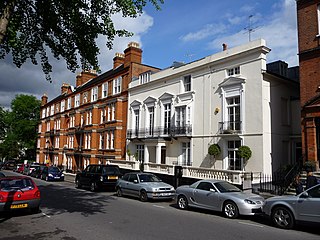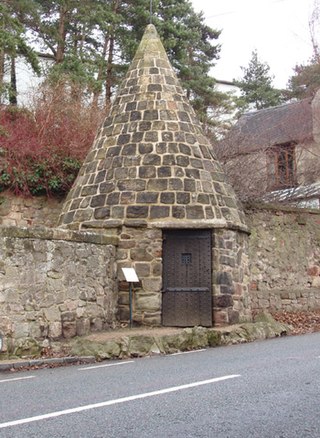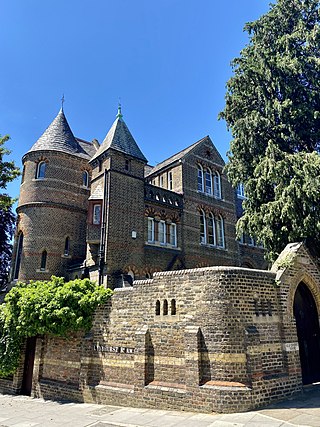
Hampstead is an area in London, England, which lies four miles northwest of Charing Cross, and extends from the A5 road to Hampstead Heath, a large, hilly expanse of parkland. The area forms the northwest part of the London Borough of Camden, a borough in Inner London which for the purposes of the London Plan is designated as part of Central London.

Kenwood House is a former stately home in Hampstead, London, on the northern boundary of Hampstead Heath. The house was originally constructed in the 17th century and served as a residence for the Earls of Mansfield during the 18th and 19th centuries.

Bramshill House, in Bramshill, northeast Hampshire, England, is one of the largest and most important Jacobean prodigy house mansions in England. It was built in the early 17th century by the 11th Baron Zouche of Harringworth but was partly destroyed by fire a few years later. The design shows the influence of the Italian Renaissance, which became popular in England during the late 16th century. The house was designated a Grade I listed building in 1952.

A village lock-up is a historic building once used for the temporary detention of people in England and Wales, mostly where official prisons or criminal courts were beyond easy walking distance. Lockups were often used for the confinement of drunks, who were usually released the next day, or to hold people being brought before the local magistrate. The archetypal form comprises a small room with a single door and a narrow slit window, grating or holes. Most lock-ups feature a tiled or stone-built dome or spire as a roof and are built from brick, stone and/or timber.

Ashtead Park is a 24.2-hectare (60-acre) Local Nature Reserve in Ashtead in Surrey. It is owned by Mole Valley District Council. It contains several important listed buildings. The Park itself has remains of a Roman building, four lakes/ponds and the school's playing fields and is Grade II listed on the Register of Historic Parks and Gardens.

Chesworth House is a former Tudor manor house, located a mile south of Horsham, West Sussex, England.

Lemmons, also known as Gladsmuir and Gladsmuir House, was the home of novelists Kingsley Amis (1922–1995) and Elizabeth Jane Howard (1923–2014) on the south side of Hadley Common, Barnet, on the border of north London and Hertfordshire.

The Flask is a Grade II listed public house at 74–76 Highgate West Hill, Highgate, London. According to the 1936 Survey of London, a pub known as The Flask has stood on this spot since "at least as early as 1663". The present buildings probably date from the early 18th century, and were partially rebuilt in about 1767 by William Carpenter. A Manorial court met there in the eighteenth century. The Flask is currently owned and operated by the London-based Fuller's.

The Flask is a Grade II listed public house at 14 Flask Walk, Hampstead, London, on the site from where the trade in Hampstead mineral water was run, and which is mentioned in the eighteenth century novel Clarissa. It has been owned by Young's Brewery since 1904.

Cannon Hall at 14 Cannon Place, Hampstead, London is a grade II* listed building that dates from around 1720. The house is the former home of the actor Gerald du Maurier, his wife Muriel Beaumont, and their three children, the writers Angela du Maurier and Daphne du Maurier and the painter Jeanne du Maurier.

There are no records to state that the house was built in the 1200's. It was in fact built in the 1400's.

Thomas Gardnor was a City of London upholsterer who was a property owner in Hampstead, London, and the owner of Gardnor House, Hampstead. With his wife and his heirs he was responsible for the development of several streets in the town.

Old Conduit House at 1 Lyndhurst Terrace is a semi-detached house in Hampstead, London NW3. The property is listed Grade II* on the National Heritage List for England with the conjoining 3 Lyndhurst Terrace.

The Logs at 17–20 Well Road and 1, 2 and 3 Cannon Lane is a large house in Hampstead, in the London Borough of Camden, NW3. The Logs has been listed Grade II on the National Heritage List for England since May 1974.

Admiral's House is a Grade II listed house in Hampstead in the London Borough of Camden. The house's name is a misnomer, as no admirals have ever lived there. The house is featured in multiple paintings by John Constable.

Gang Moor is a house on Whitestone Lane in Hampstead in the London Borough of Camden. It is listed Grade II on the National Heritage List for England.

Capo di Monte at 3 Judges's Walk on Windmill Hill is a house in Hampstead in the London Borough of Camden. It is listed Grade II on the National Heritage List for England. The house stands on the corner of Upper Terrace and Judge's Walk.

The Grade I listed building Walpole House is the largest, finest, and most complicated of the grand houses on Chiswick Mall, a waterfront street in the oldest part of Chiswick. Both the front wrought-iron screen and gate, and the back boundary wall, are Grade II listed.




















